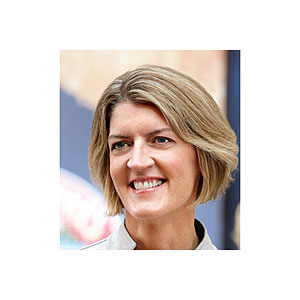Beth Ford, executive vice president, chief supply chain and operations officer for Land O’Lakes, Arden Hills, Minn., talks with Refrigerated & Frozen Foods about  the logistics of the supply chain industry and how food production continues to experience great growth.
the logistics of the supply chain industry and how food production continues to experience great growth.
Refrigerated & Frozen Foods: You were named on the panel of the Council of Supply Chain Management Professionals’ (CSCMP) State of Logistics Report. From your perspective, what is the state of the logistics?
Beth Ford: Land O’Lakes has been undergoing tremendous growth over the last number of years, even through the economic challenges, because the agricultural and dairy portfolios have been growing rapidly. We were up about 10% in sales last year and about another 8% this first quarter [of 2013], which puts us at Fortune’s No. 194. So, the growth has been there. At the same time, you saw what was going on with the industry; there was a lot of economic disruption in prior years, reducing the ability of many carriers to push on rate. We’re seeing some strengthening now; there’s increased pricing, especially in refrigerated trucking and domestic trucking and supply is tightening a bit.
Of course, driver turnover is a constant challenge and will be in the foreseeable future. Most truckers have kept their supply stable or have reduced equipment. Government regulations continue to add challenges to the industry in terms of hours of service changes, safety program changes, emission standards changes, etc. So, there’s some complexity, but I’d say in many of the logistics areas, we’re seeing some increased pricing and supply tightening. There was some tight supply in Q4 of 2012, for instance; we worked around that. We gave a forward view to our customers and to our partners in the business, but I think that’s a reflection of some of the tight supply and trucking capacity in the industry.
In warehousing, we see flat-to-slightly-increasing rates and increased supply. Refrigerated warehousing is tighter, as providers are reluctant to spend capital on refrigeration until the market is fully up and strong. Public warehousing is expected to grow by 5% annually over the next several years, so warehousing has been a bit flat, but we’re starting to see an increase in rates and some increased demand and supply.
Rail rates are [experiencing] some inflationary rate increases. Of course, the rails have really been making investments over the long term, and the domestic trucking market has been tightening, so they’ve been able to take advantage of that. They have really re-invested in their infrastructure. That means rail equipment and rail capacity is newer, the railroads have streamlined their operations to get more efficiency out of their crews and they’re focusing on customer service initiatives. As you see truck rates increase and as you see capacity tighten, you see rail as a decent option.
And fuel has been stable. I think the energy department is projecting fuel pricing to be stable for the next couple of years because of the shale gas production here in the United States. So, we’re seeing some stability there where as in a few years ago, that was a very volatile area.
R&FF: You also spoke at the Voorhees Supply Chain Conference on April 5. What are some of the key topics you discussed?
Ford: I really spoke on mega-trends in supply chain tied to food production and the food production imperative—the implications for growth in global population and the fact that we’re going to have to produce more with fewer resources.
For all companies involved in food production and supply chain, we call this a period of great growth. Food production is a great growth industry. Worldwide population projected to grow to 9 billion by 2050, and it’s at about 6 billion now. So, the demand for agriculture production and food production are significant.
We do a lot of work on dairy powders, which are input into many food stuffs that are shipped around the world. It’s a key element for many emerging markets. But, I would put it a step behind something that’s more of a direct domestic implication for refrigerated and dairy.
R&FF: Summarize Land O’Lakes’ approach to supply chain and logistics.
Ford: In my portfolio, I have all of the businesses, so we are a bit unique in that we do go farm to fork. We are farmer-owned and have core agriculture businesses such as Purina Animal Nutrition (animal feed) and WinField Solutions, which is seed and crop protection. Those two businesses are approximately $9 billion in sales; $5 billion of our top line resides in our dairy portfolio.
We have more of what I would call a functional but integrated structure, which means supply chain includes sourcing, trading, hedging, manufacturing, logistics, planning, warehousing, strategy, etc.; it’s across all of our businesses. We try to drive capability to capture growth vs. acting as a pure service unit. We take the approach of being a business unit, and that means that we try to drive profitability to the organization to develop businesses (3PL, merchandising) that actually deliver revenue and income.
R&FF: What are some of your customers’ biggest supply chain concerns? And, what is Land O’Lakes doing to address these challenges?
Ford: All of our customers want innovative products. That drives a lot of conversations. Last year, we purchased Kozy Shack, the pudding company [based in
"All of our customers want innovative products. That drives a lot of conversations." |
Hicksville, N.Y.]. Refrigerated desserts have been in decline as a category, but Kozy Shack has been growing rapidly and taking great share leveraging its simple product ingredient formula.
What drives every conversation with customers and what they’re really concerned about is something that’s new, what drives customer interaction, what will drive revenue for them. What a customer is most focused on is managing the availability, their working capital investment and their efficiency in their service levels. But, a lot of that comes under the context of what is the product portfolio that you’re putting in front of them. We happen to think at Land O’Lakes, especially in our dairy and in our refrigerated portfolio, that we have the leading brand in butter and in cheese, and now Kozy Shack is a huge success for us. And, when you have that kind of brand power that allows the conversation with a retailer or a customer that is more holistic, it’s not necessarily driven by day-to-day. It’s “I want x, y and z on my supply chain.” Even with that, I would always fall back on, every customer wants good working capital efficiencies, every customer wants good service levels and they want good availability and tight partnerships to manage volatility in their own portfolio.
We have a very strong and capable planning, warehousing and logistics group. We’ve implemented a consistent demand planning platform and process. We’re doing some innovative things in customer data to look at their volatility. It gives us early visibility to demand, especially with new product launches, which allows us to be in the appropriate position with the supply. At a more tactical level, the efficiency of that and the capability of a tight relationship using customer data and working on jointly understanding the volatility for the product portfolio on the shelf provides a lot of benefit for the customer and for us to make sure that we’re all managing supply effectively.
R&FF: What are some of your company’s supply chain projects for 2013? Any initiatives in place for 2014?
Ford: One of the things that we worked on last year is that we looked at a full marketplace-backed network analysis for each of our products and each of our portfolios across agriculture, feed and dairy businesses, to make sure that we have an optimized network tied to the long-term growth trajectory of the businesses. The businesses did a marketplace review that would look out 4-5 or 5-10 years by category, and we then matched our manufacturing and logistics capacity and our network design to make sure that we had a capital strategy that made sense. It’s absolutely critical as we try to position our personnel to develop our competency to make sure we have our best talent involved in these growth opportunities.
What we’re doing this year is in some regards is executing on some of that plan with different investments that we make either in equipment or assets. Additionally, we are moving on talent development to position our employees in different locations. We’ve also made some structural changes to make sure that we’ve understood the economics of the decisions that we’re making, so we pulled in a dairy economics group and separated it from other groups, which allows us to have better visibility for different market-based decisions we’re making.
And then finally, one of the key areas that we’re most focused on, just like most supply chain organizations, is talent development. We are growing so rapidly, and we have hundreds of locations with a lot of employees, so we need the best-in-class talent from a leadership perspective and from a supply chain and operating perspective. We’re really lending into that with our own talent development and leadership development programs, and we’re focused on recruiting and working with interns and new hires to start to get folks excited about the industry and excited about supply chain and operations as a field. There’s a shift in the field where many organizations are moving over to the model that I discussed, which is where you are a key partner in the business. You’re a business unit viewed as a line function or a line business vs. viewed as a service unit. There’s nothing wrong with being a service unit, but it does change the dynamic and the expectation in terms of the talent that we will recruit for and what we require in terms of their business capability in addition to their operating capability.
ABOUT BETH FORD
Beth Ford, executive vice president, chief supply chain and operations officer, joined Land O’Lakes in January 2012. In this role, she is responsible for all supply chain and operating functions from sourcing to customer delivery. During her 25-plus-year career, Ford has held line operating and senior leadership positions with global companies in multiple industries, including chemicals, consumer package goods, publishing and oil and gas.


